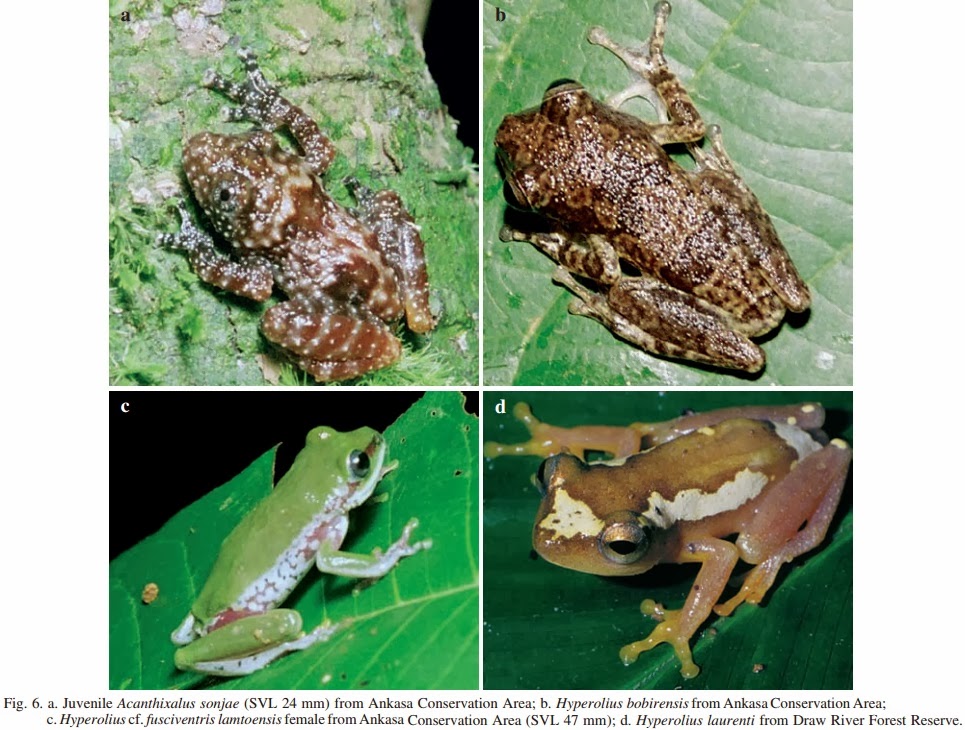![]() |
Odontobatrachus natator (Boulenger, 1905)
photo: Mark-Oliver Rödel |
Abstract
BackgroundHigher-level systematics in amphibians is relatively stable. However, recent phylogenetic studies of African torrent-frogs have uncovered high divergence in these phenotypically and ecologically similar frogs, in particular between West African torrent-frogs versus Central (Petropedetes) and East African (Arthroleptides and Ericabatrachus) lineages. Because of the considerable molecular divergence, and external morphology of the single West African torrent-frog species a new genus was erected (Odontobatrachus). In this study we aim to clarify the systematic position of West African torrent-frogs (Odontobatrachus). We determine the relationships of torrent-frogs using a multi-locus, nuclear and mitochondrial, dataset and include genera of all African and Asian ranoid families. Using micro-tomographic scanning we examine osteology and external morphological features of West African torrent-frogs to compare them with other ranoids.
ResultsOur analyses reveal Petropedetidae (Arthroleptides, Ericabatrachus, Petropedetes) as the sister taxon of the Pyxicephalidae. The phylogenetic position of Odontobatrachus is clearly outside Petropedetidae, and not closely related to any other ranoid family. According to our time-tree estimation Odontobatrachus has been separated from other frog lineages since the Cretaceous (90.1 Ma; confidence interval: 84.2-97.1 Ma). Along with this molecular evidence, osteological and external diagnostic characters recognize West African torrent-frogs as distinct from other ranoids and provide strong support for the necessity of the recognition of a new family of frogs. This is the only endemic vertebrate family occurring in the Upper Guinea biodiversity hotspot.
ConclusionBased on molecular and morphological distinctiveness, the West African torrent-frog Odontobatrachus natator is allocated to a newly described anuran family. The discovery of an endemic vertebrate family in West Africa highlights the Upper Guinean forests as an outstanding, but highly endangered biodiversity hotspot.
Keywords: Amphibia, Anura, Ranoidae, Natatanura, Odontobatrachidae fam. nov., Petropedetidae, Biodiversity hotspot, Higher level systematics, Molecular phylogeny, Osteology, West Africa
![]() |
Odontobatrachus natator (Boulenger, 1905)
photo: Mark-Oliver Rödel |
Amphibia Linnaeus, 1758
Lissamphibia Haeckel, 1866
Anura Rafinesque, 1815
Neobatrachia Reig, 1958
Odontobatrachidae fam. nov.
Type genus: Odontobatrachus Barej, Rödel, Loader & Schmitz, 2014
Type species: Petropedetes natator Boulenger, 1905
Distribution: The single included genus is known from the Upper Guinean forests in Guinea, Sierra Leone, Liberia, and western Ivory Coast, where frogs usually occur close to streams with strong currents and cascades or rapids.
Diversity: At present a single species is described, Odontobatrachus natator (Boulenger, 1905). However, Barej et al. already recognized a higher diversity in this lineage and a more detailed taxonomic analysis of the family throughout the distribution range in the Upper Guinea forests is in preparation (M.F. Barej et al. unpubl. data).
Etymology: The name refers to the Greek words όδούς (odous = tooth, genitive: odóntos) and βατραχοσ
(batrachos = frog) and points to the exceptionally long maxillary teeth and large tusks on
lower jaws in these frogs (Figure 2).
Barej, M.F., A. Schmitz, R. Günther, S.P. Loader, K. Mahlow & M.-O. Rödel. 2014. The First Endemic West African Vertebrate Family – A New anuran Family highlighting the uniqueness of the Upper Guinean Biodiversity Hotspot.
Frontiers in Zoology. 11:8 doi:
dx.doi.org/10.1186/1742-9994-11-8
The new family of frogs toothed Guinea
... and the tree frog with the dentures of the Republic (GALLERY)














































